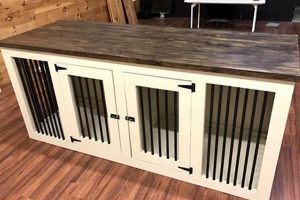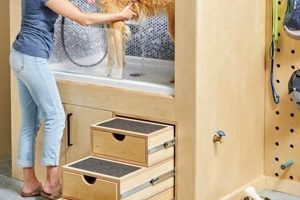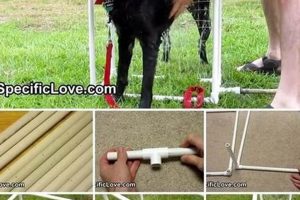A designated area, often constructed or modified by the owner, where a canine can be bathed, brushed, and trimmed at home is the subject of interest. This setup provides a controlled environment for tending to a dog’s hygiene needs, eliminating the need for professional grooming services, although some owners use both options.
The practice offers numerous advantages. It allows pet owners to closely monitor their animal’s health and hygiene, and it could be a cost-effective alternative to engaging professional groomers regularly. Moreover, it presents an opportunity to strengthen the bond between owner and pet through consistent, caring interaction, and reduce anxiety in dogs that dislike external grooming establishments.
The following sections explore elements to consider when establishing a dedicated in-house canine care spot, encompassing design considerations, necessary equipment, and best practices for ensuring a safe and effective grooming experience.
Establishing a Dedicated Canine Hygiene Area
This section outlines key considerations for constructing a practical and safe place for canine upkeep within the home. Adhering to these recommendations will aid in creating an efficient setup.
Tip 1: Location Selection: Choose a location with water access and suitable drainage. A laundry room or utility sink area is generally practical. Access to an outdoor space is also advantageous, particularly for pre-bathing rinsing to remove loose dirt.
Tip 2: Surface Protection: Install non-slip flooring or mats to prevent accidents. Canine mobility can be uncertain when wet, and the risk of slips and falls must be mitigated.
Tip 3: Tub or Elevated Platform: Consider a specialized bathing tub or an elevated platform to reduce strain on the owner’s back. An appropriate height for canine access and owner comfort is crucial.
Tip 4: Restraint System: Integrate a secure restraint system, such as a grooming loop, to prevent the canine from jumping or moving excessively during the grooming process. Safety is paramount.
Tip 5: Adequate Lighting: Implement sufficient lighting to ensure clear visibility during grooming. Proper illumination allows for careful monitoring of skin and coat condition.
Tip 6: Ventilation: Ensure adequate ventilation to prevent moisture buildup and promote air circulation, particularly when using heated drying equipment. Proper ventilation contributes to the canine’s comfort.
Tip 7: Storage Solutions: Incorporate accessible storage for grooming tools and supplies. Organization promotes efficiency and reduces clutter, which can be a safety hazard.
These directives, when implemented, contribute to a secure, efficient, and well-organized environment for domestic canine grooming. This, in turn, can positively influence the experience for both owner and pet.
The following sections will delve into the necessary equipment and product considerations for maintaining the canine’s well-being.
1. Location Accessibility
Location accessibility exerts a primary influence on the practicality and long-term utilization of a home-based canine cleaning area. An inconveniently located setup will likely discourage frequent grooming, negating many of the potential benefits of a do-it-yourself approach. Proximity to essential utilities such as water supply and drainage is paramount. A remote location lacking these provisions would necessitate cumbersome solutions for water management, increasing both the physical labor and the overall time investment involved. This logistical hurdle frequently leads to infrequent or incomplete hygiene maintenance, impacting the animals well-being.
Practical examples illustrate this principle. A grooming space situated within a utility room adjacent to a water heater, for instance, provides convenient access to both warm water and drainage, streamlining the bathing process. Conversely, a setup in a detached garage requiring transport of water and disposal of wastewater will likely be used less often. Moreover, accessibility should extend to the pet itself; a location requiring navigating steep stairs or narrow passages may be unsuitable, especially for older or mobility-impaired dogs. This highlights the need for a location that is easy for both canine and owner to access.
Ultimately, prioritizing location accessibility is not merely a matter of convenience; it directly affects the frequency and quality of at-home canine hygiene practices. A conveniently positioned and readily accessible setup promotes consistent grooming, contributing to the overall health, hygiene, and well-being of the canine. Conversely, neglecting this fundamental consideration can render the entire endeavor impractical and ultimately counterproductive, rendering the setup abandoned. This consideration serves to be a crucial initial step in realizing a practical and beneficial DIY cleaning space.
2. Surface Safety
Surface safety within a domestic canine grooming area represents a non-negotiable aspect of responsible pet care. The selected flooring and platform materials directly impact the canine’s stability, thereby influencing the overall safety and comfort of the grooming procedure. This consideration extends beyond mere convenience, encompassing the prevention of potential injuries arising from slips, falls, and inadequate traction during bathing and handling.
- Slip Resistance
The primary function of a safe surface is to provide adequate grip, particularly when wet. Smooth, polished surfaces such as tile or finished concrete present a significant slip hazard for canines, especially those with longer hair or compromised mobility. Materials such as textured rubber, non-slip mats, or epoxy coatings enhance traction, reducing the risk of falls and subsequent injuries, including strains, sprains, and fractures.
- Water Impermeability
A safe surface must be impervious to water penetration. Porous materials like untreated wood or certain types of grout can absorb water, creating breeding grounds for mold and bacteria. Furthermore, water accumulation can compromise the structural integrity of the flooring over time, leading to instability. Non-porous materials, properly sealed surfaces, or integrated drainage systems are crucial for maintaining a hygienic and structurally sound environment.
- Ease of Cleaning
Regular cleaning is essential for maintaining a hygienic grooming space. Surfaces that are difficult to clean, such as those with deep textures or intricate patterns, can harbor dirt, hair, and bacteria. Smooth, easily wipeable surfaces facilitate thorough cleaning, reducing the risk of skin infections and other hygiene-related issues. Choosing materials that are resistant to common cleaning agents is also important to prevent damage or discoloration.
- Cushioning and Support
Prolonged standing on hard surfaces can cause fatigue and discomfort for both the canine and the groomer. Surfaces with integrated cushioning or the use of padded mats can reduce strain on joints and muscles. This is particularly important for older dogs or those with arthritis. Adequate cushioning can also minimize the impact of accidental falls, further enhancing overall safety.
In summary, the selection of surface materials within a home canine grooming space constitutes a critical safety consideration. Prioritizing slip resistance, water impermeability, ease of cleaning, and cushioning provides a secure and comfortable environment for the canine, minimizing the risk of injuries and promoting a positive grooming experience. A well-chosen surface, therefore, contributes significantly to the overall effectiveness and long-term viability of a domestic grooming setup.
3. Ergonomic Height
The ergonomic height of a domestic canine grooming station directly impacts the physical well-being of the human caregiver. An improperly configured grooming area necessitates excessive bending, stooping, or reaching, increasing the risk of musculoskeletal strain and long-term injury. This directly undermines the sustainability of at-home grooming practices. For instance, repeatedly lifting a medium-sized dog into a tub that is too low places undue stress on the lower back. The inverse is also true; a surface too high requires the caregiver to raise their arms above shoulder level, leading to shoulder and neck discomfort. Thus, careful consideration of the work surface height is paramount in any plan for a domestic canine cleaning location.
Establishing an appropriate height involves several practical considerations. The ideal height is generally considered to be at or slightly below the caregiver’s elbow when standing. This positioning allows for optimal leverage and minimizes strain on the back and shoulders. Adjustable grooming tables or platforms offer a versatile solution, accommodating different dog sizes and caregiver heights. Failing to address this element can result in chronic pain or injury, negating the potential cost savings and convenience associated with at-home grooming. A case study involving veterinary technicians revealed a significant correlation between poorly designed grooming stations and increased rates of back pain. The implications for non-professional groomers are similar: neglecting ergonomics can lead to physical problems.
In summary, ergonomic height is not a peripheral concern but a fundamental component of a functional and sustainable domestic canine grooming setting. By prioritizing the physical well-being of the caregiver through careful consideration of working height, the long-term viability and enjoyment of at-home grooming are significantly enhanced. Disregarding this aspect introduces the risk of injury, potentially undermining the benefits of a DIY approach.
4. Secure Restraint
The implementation of secure restraint within a domestic canine grooming area directly affects safety and efficiency. Unrestrained canines pose a risk of injury to themselves and the groomer, while also hindering the completion of necessary hygiene tasks. Restraint systems are not merely a matter of convenience, but a fundamental component that enables proper cleaning, trimming, and examination of the animal.
Effective restraint methods within a domestic setting typically involve grooming loops attached to a stable surface, or specialized harnesses designed to limit movement. The selection of an appropriate system depends on the temperament and size of the canine. An anxious or energetic dog necessitates a more robust restraint than a calm, cooperative animal. Failing to employ adequate restraint can lead to abrupt movements that cause cuts, scratches, or other injuries during grooming procedures. This can also result in heightened anxiety in the canine, making future grooming sessions more difficult. Some canines may attempt to escape the grooming area without proper restraint, causing damage to property or injury to themselves. An example can be found when attempting to clip toenails on a dog that doesn’t like nail clipping: a grooming loop helps keep the dog in place to prevent injuries.
In conclusion, secure restraint is an indispensable element of any domestic canine grooming setting. Its implementation safeguards the well-being of both the canine and the groomer, while also facilitating the effective and efficient completion of necessary hygiene practices. Ignoring restraint considerations introduces unnecessary risks and reduces the likelihood of successful at-home grooming.
5. Adequate Lighting
Adequate illumination within a domestic canine grooming space transcends mere aesthetic considerations, representing a foundational safety and effectiveness element. Insufficient or improperly positioned lighting directly compromises the ability to perform thorough hygiene maintenance, potentially leading to overlooked health issues and increased risk of injury.
- Early Detection of Skin Abnormalities
Proper lighting facilitates early detection of skin conditions. Poorly lit environments obscure subtle changes in skin color, texture, or the presence of parasites. For example, early identification of flea infestations or the emergence of skin infections, such as ringworm, depends on clear visibility. Adequate lighting enables thorough inspection of the canine’s coat and skin, allowing for prompt treatment and preventing the escalation of minor issues into more serious health concerns. The location provides for accurate assessment during grooming activities.
- Precise Grooming Procedures
Trimming nails and cleaning ears requires precision. Shadows and dim lighting obscure fine details, increasing the likelihood of accidental cuts or injuries. Sharp grooming tools, such as clippers and scissors, necessitate careful handling and visual clarity. For instance, trimming a dog’s nails too short can cause bleeding and pain. Proper illumination ensures accurate placement of grooming tools, reducing the risk of injury and promoting a more comfortable experience for the animal. The light source will provide the clarity for exact trimming.
- Enhanced Safety and Reduced Risk of Accidents
Adequate lighting minimizes the risk of accidents within the grooming area. Shadows and poorly lit corners can obscure obstacles or uneven surfaces, increasing the risk of slips and falls. During bathing, adequate illumination is essential for monitoring the canine’s behavior and ensuring their safety. For example, observing signs of distress or discomfort is more difficult in dimly lit conditions. Proper lighting creates a safer environment for both the animal and the groomer, reducing the potential for accidents and injuries. This will promote safe practices for all users.
- Comprehensive Assessment of Grooming Quality
The final assessment of the completed grooming process depends on proper lighting. Insufficient illumination can mask uneven haircuts, missed spots during bathing, or residual debris in the coat. A thorough evaluation of the grooming outcome is essential for ensuring a satisfactory result and maintaining the canine’s hygiene. For example, identifying and correcting missed spots during brushing is more effective under proper lighting. Adequate lighting facilitates a comprehensive assessment of the grooming quality, promoting owner satisfaction and contributing to the canine’s overall well-being.
These factors underscore the importance of adequate lighting in a home canine grooming setting. The aforementioned examples showcase the practical implications of this element, highlighting how proper illumination is essential for maintaining the safety, effectiveness, and overall quality of at-home canine hygiene practices.
6. Ventilation Quality
Ventilation quality within a domestic canine grooming station directly impacts the health and comfort of both the animal and the caregiver. Inadequate ventilation contributes to a buildup of humidity, airborne particles (hair, dander), and odors associated with grooming products. This creates an environment conducive to respiratory irritation, allergic reactions, and the proliferation of mold and bacteria. The consequences range from minor discomfort to more significant health risks, directly affecting the viability and sustainability of a DIY grooming setup.
Consider the practical implications. During bathing, especially with warm water, humidity levels increase significantly. Without proper ventilation, this moisture condenses on surfaces, promoting mold growth. Furthermore, the drying process, whether natural or aided by a canine-specific dryer, releases substantial amounts of hair and dander into the air. These particles can trigger allergic reactions or exacerbate existing respiratory conditions. Similarly, the use of grooming sprays, shampoos, and other products introduces volatile organic compounds (VOCs) into the air. Poor ventilation traps these VOCs, increasing the risk of respiratory irritation. Installing exhaust fans or ensuring sufficient airflow through open windows are mitigating strategies. Additionally, using air purifiers with HEPA filters reduces airborne particles and odors.
Effective ventilation should remove moisture, airborne particles, and chemical odors while maintaining a comfortable temperature. Without these considerations, the long-term utility of a DIY canine grooming station will be compromised by potential health hazards. Prioritizing ventilation represents a crucial step in establishing a safe, healthy, and effective grooming environment.
7. Organized Storage
Within a domestic canine grooming area, the establishment of organized storage solutions functions as a critical determinant of efficiency, safety, and long-term sustainability. A systematic approach to the arrangement of tools and supplies directly contributes to the overall functionality of the grooming station, mitigating potential hazards and promoting a streamlined workflow.
- Enhanced Efficiency of Grooming Process
Systematic tool placement reduces time expenditure. Immediate access to necessary items eliminates the interruption caused by searching for misplaced implements. A designated space for each itembrushes, clippers, shampoosincreases workflow speed. For example, a wall-mounted rack for holding clippers and a labeled container for shampoos promote rapid access. This translates directly to a more efficient and less stressful grooming session for both caregiver and canine.
- Mitigation of Safety Hazards
Proper storage minimizes risks associated with grooming tools. Sharp implements, such as scissors and nail trimmers, require secure containment to prevent accidental injuries. Unsecured electrical cords from clippers or dryers create trip hazards. Organized storage reduces the likelihood of such incidents. Locking cabinets or drawers for hazardous items and cord management systems for electrical appliances effectively prevent accidents.
- Preservation of Tool Integrity
Dedicated storage solutions prolong the lifespan of grooming equipment. Exposure to moisture, dust, or physical impact degrades the functionality of tools. A dry, climate-controlled storage area minimizes corrosion and damage. Individual tool compartments or cases prevent scratching and breakage. Regular cleaning and maintenance, facilitated by organized access, further extends equipment longevity.
- Optimized Use of Space
Effective storage maximizes available space, particularly in confined grooming areas. Wall-mounted shelves, drawers, and vertical storage units allow for efficient utilization of vertical space. Folding grooming tables and stackable containers create adaptable storage solutions. This optimization prevents clutter and ensures a comfortable working environment, even in small grooming areas.
In summation, the implementation of well-defined storage strategies represents an integral component of a functional and safe DIY canine grooming space. The benefits extend beyond mere aesthetic appeal, encompassing enhanced efficiency, mitigated hazards, prolonged tool lifespan, and optimized space utilization. A carefully planned storage system directly contributes to a positive and sustainable at-home grooming experience.
Frequently Asked Questions Regarding Domestic Canine Grooming Stations
This section addresses common inquiries concerning the establishment and maintenance of a designated area for canine hygiene within the home.
Question 1: What is the minimum space requirement for a functional domestic canine grooming station?
The minimum space is contingent upon the size of the canine and the scope of grooming activities. A dedicated area of approximately 4 feet by 6 feet is generally adequate for small to medium-sized canines. Larger breeds may necessitate a larger area to facilitate movement and prevent overcrowding. Vertical space for storage must also be considered.
Question 2: Is professional installation of plumbing necessary for a domestic canine grooming station?
Professional plumbing installation is recommended to ensure compliance with local building codes and to prevent water damage. Improper plumbing connections can lead to leaks, water contamination, or structural damage. Alternatively, portable bathing solutions can be employed, albeit with reduced convenience.
Question 3: What are the essential grooming tools required for a basic domestic canine grooming station?
Essential tools include a canine-specific shampoo, a variety of brushes appropriate for the canine’s coat type, nail trimmers, ear cleaning solution, and a high-velocity dryer. Additional tools may be required depending on the desired grooming style and the canine’s specific needs.
Question 4: How frequently should a domestic canine grooming station be cleaned?
The grooming area should be cleaned after each grooming session to remove hair, dander, and debris. Regular disinfection is also recommended to prevent the growth of bacteria and fungi. The frequency of disinfection depends on the level of usage and the presence of any skin conditions.
Question 5: What safety precautions should be observed when using electrical appliances in a domestic canine grooming station?
Electrical appliances, such as dryers and clippers, should be used with caution in a wet environment. Ground fault circuit interrupters (GFCIs) should be installed to prevent electrical shock. Cords should be kept away from water sources and inspected regularly for damage. Appliances should be unplugged when not in use.
Question 6: Are there any specific regulations or building codes pertaining to the construction of a domestic canine grooming station?
Local building codes may dictate requirements for plumbing, electrical wiring, and ventilation. It is advisable to consult with local authorities to ensure compliance with all applicable regulations before commencing construction. Failure to comply with building codes can result in fines or legal action.
In summary, establishing and maintaining a dedicated canine grooming area necessitates careful planning, adherence to safety protocols, and compliance with applicable regulations. Thorough research and consultation with professionals are recommended to ensure a successful and sustainable grooming setup.
The following section provides guidance on sourcing materials and selecting equipment for a domestic canine grooming station.
Conclusion
The preceding discussion presented comprehensive considerations for establishing a “diy dog grooming station.” Key elements encompassing location selection, surface safety, ergonomic height, secure restraint, adequate lighting, ventilation quality, and organized storage were outlined. These factors collectively influence the functionality, safety, and sustainability of a home-based canine hygiene practice. Furthermore, frequently asked questions were addressed, clarifying essential aspects of construction, maintenance, and regulatory compliance.
The implementation of a dedicated canine care spot necessitates meticulous planning and adherence to recommended safety protocols. Prudent execution not only facilitates efficient grooming procedures but also contributes to the overall well-being of both the canine and the caregiver. As pet ownership trends toward greater emphasis on preventative care and domestic convenience, the importance of a thoughtfully designed “diy dog grooming station” remains paramount. Future advancements in ergonomic design and specialized grooming equipment may further enhance the efficiency and accessibility of this practice.







